Carolina Cherry Laurel (Prunus Caroliniana): Leaves, Flowers, Berries (Pictures) – Identification and Care Guide
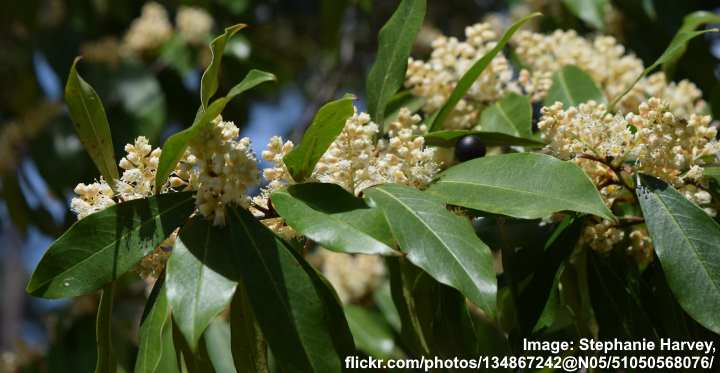
Carolina cherry laurel is a popular evergreen shrub, and it’s an excellent choice for hedges and privacy screens. The plant’s best features are its attractive densely growing foliage and showy flowers. Carolina cherry laurel plants are identified by shiny green lance-shaped leaves, attractive white flowers, and black berries in the fall. Both the leaves and flowers produce a pleasant fragrance.
Carolina cherry laurel has many uses in the garden landscape. But most gardeners prize this dense shrub as an evergreen privacy hedge, living fence, or windbreak. Additionally, you can plant a Carolina cherry laurel as a foundation planting, border shrub, or specimen plant.
Another reason why this cherry laurel variety is so popular is due to its low-maintenance characteristics. The Carolina cherry laurel is a hardy plant that performs well in full sun to part shade. And even full shade isn’t detrimental to its growth. The plant tolerates most soils and conditions. All you need is some light pruning once a year to maintain an informal evergreen hedge in your front or backyard.
This article is a comprehensive guide to growing a Carolina cherry laurel hedge plant in your garden. Descriptions and pictures of laurel leaves, flowers, and berries will help identify this stunning plant.
About Carolina Cherry Laurel (Prunus caroliniana)

Carolina Cherry Laurel (Prunus caroliniana)
Carolina cherry laurel is a variety of native shrub in the genus Prunus and evergreen family Rosaceae. The beautiful hedge plant grows 15 to 20 ft. (4.5 – 6 m) tall. This cherry laurel variety has a dense, pyramidal to oval habit and fast growth. Because it thrives in most soils, it grows easily in most landscapes.
The name cherry laurel comes from the distinctive shape of the shrub’s leaves. The pointed, leathery leaves look like laurel leaves from the unrelated bay laurel plant (Laurus nobilis). However, it’s dangerous to get the leaves mixed up because Carolina cherry laurel leaves are poisonous, unlike the aromatic bay leaves.
Similarly, you shouldn’t eat any of the black berries growing on the cherry laurel. Although the small berry-like drupes look like tiny cherries, they also contain toxic chemicals. Therefore, if you grow a Carolina cherry laurel in your landscape, it’s vital to ensure pets and children don’t consume the leaves or berries.
Compared to the cherry laurel (Prunus laurocerasus) and skip laurel (Prunus laurocerasus ‘Schipkaensis’), the Carolina cherry laurel isn’t as cold-hardy. Therefore, the shrub is only suitable for growing as a hedge, foundation plant, or border in USDA zones 7 through 9. However, this makes the bushy shrub popular for hedges in southern states and Florida.
Like other shrubs in the Prunus genus, the Carolina cherry laurel has rapid growth. You can expect the shrub to grow one to two feet (30 – 60 cm) annually in ideal conditions. All you need to do to encourage fast growth is keep the soil moist and well-drained. However, the good news is that Carolina cherry laurel is a drought-tolerant evergreen plant once established.
Carolina Cherry Laurel Hedge
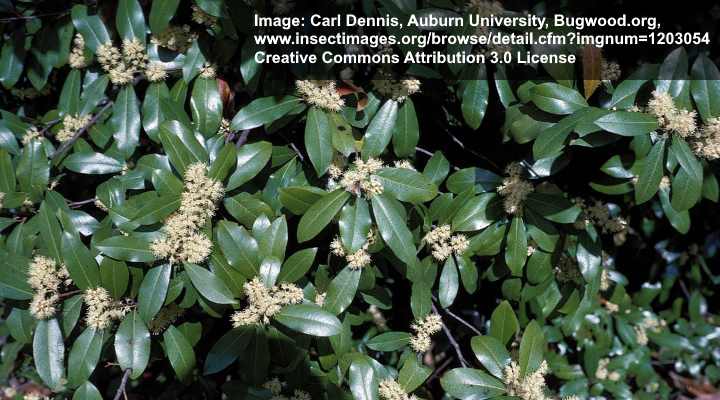
Carolina cherry laurel is a great choice for hedges or privacy living fence
A Carolina cherry laurel plant creates a beautiful privacy screen, backyard hedge, living fence, or windbreak. The dense shrub grows quickly and adds year-long color to your landscape. Flowers in the spring, berries in the fall, and evergreen leaves will enhance the beauty of your property.
Carolina cherry laurel is a low-maintenance hedge plant and is easy to maintain as an evergreen hedgerow. To keep the hedge shape, pruning once a year in spring or summer will ensure that the glossy foliage stays neat and grows well. Generally, the cherry laurel is easy to keep between 3 and 6 ft. (1 – 2 m).
Carolina Cherry Laurel Leaves
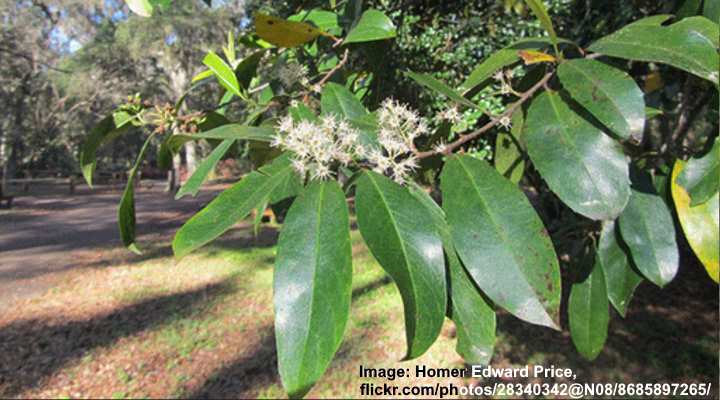
Carolina cherry laurel leaves
Leaves on the Carolina cherry laurel plant are identified as broadleaf evergreen, with an oblong, elliptical shape and pointed tips. The leaves usually have smooth margins, but sometimes they have subtle serrated margins. The thick, leathery, glossy green leaves have a smooth feel, and they grow alternately in a simple arrangement on the shrub. The cherry laurel leaves measure 2” – 3” (5 – 7.5 cm) long.
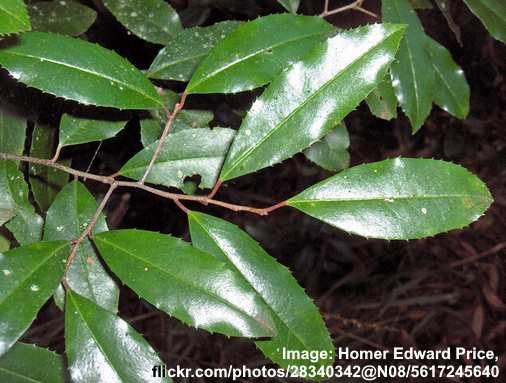
Carolina cherry laurel leaves can sometimes have subtle serrated margins
When mature, the evergreen Carolina cherry laurel shrub foliage has a dark green, lustrous appearance. The shiny leaves grow densely on the shrub, making it an ideal plant for protecting privacy in your backyard.
An identifying feature of Carolina cherry leaves is that the leaves give off an aroma of maraschino cherry or almond extract when crushed. However, this is a warning because the poisonous cherry laurel leaves contain prussic acid (cyanide) and can cause severe health complications if eaten.
How to Plant Carolina Cherry Laurel Hedge
Plant the Carolina laurel cherry shrubs 2 to 3 ft. (0.6 – 1 m) apart to grow a laurel hedge. The hedge will grow faster and denser by planting at 2 ft. (60 cm) apart. To ensure a narrow laurel hedge, you can trim the shrub every year to keep its width at around 18” (45 cm) wide.
To make planting a laurel hedge easier, some gardeners recommend digging a trench rather than individual planting holes. The planting depth should be 12” (30 cm) deep, and the roots should be just below the surface. When back-filling the planting hole, it’s a good idea to amend the soil with rotten manure or compost.
Regularly prune the upper branches to allow light to filter through the foliage. This pruning tip helps your beautiful cherry laurel hedge grow dense to the ground. In addition, you can prune a few inches of the branch tips to encourage the plant to spread out.
Carolina Cherry Laurel Fruit

The small black Carolina cherry laurel berry-like fruit is poisonous for humans but can be eaten by birds
The Carolina laurel cherry tree fruit looks like small black oval cherries with smooth skin. However, the cherry laurel black fruit isn’t clusters of berries, but they are fleshy drupes with a large stone (pith) in the center. The “berries” emerge green and ripen to reddish-purple then black by late summer or early fall.
Black Carolina cherry laurel berries measure around 0.5” (1.3 cm) in diameter. Although the berries look appealing, they are poisonous, just like other parts of the shrub. However, the sweet berries with their Maraschino cherry fragrance attract birds and wildlife. The berries also persist on the bush throughout the winter.
Carolina Cherry Laurel Flowers
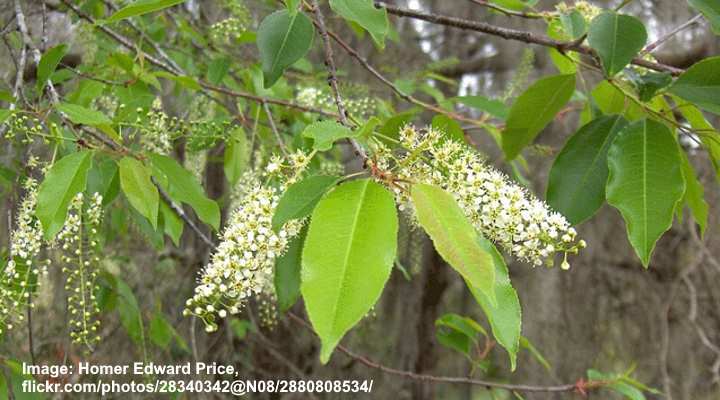
Carolina cherry laurel white flowers have a cylindrical shape
Carolina cherry laurel shrubs are easy to identify in early spring, thanks to their clusters of cylindrical attractive white flowers. Tiny white four or five-petalled flowers make up cylindrical racemes (clusters) that measure 2” to 3” (5 – 7.5 cm) long.
The cherry laurel flowers have a sweet aroma and blossom among the leaves, attracting pollinators in spring.
How to Identify Carolina Cherry Laurel
Carolina cherry laurel identification is by its aromatic pointed green leaves, cylindrical white flowers, and dense growth. The leathery leaves are lance-shaped with a glossy sheen. When in bloom, white flowers in spring give off a pleasant aroma. After blooming, clusters of green drupes emerge that turn black by late fall.
How to Use Carolina Cherry Laurel in the Landscape
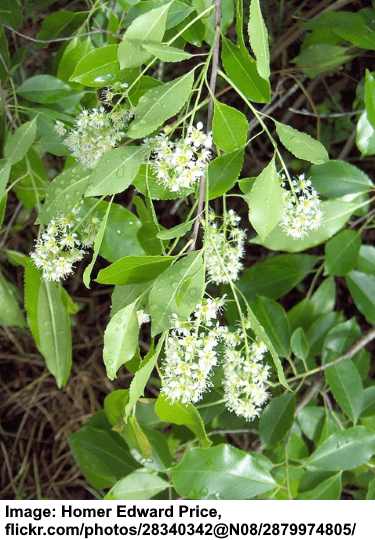
Carolina cherry laurel shrubs have many uses in a landscaped garden
Carolina cherry laurel is a versatile evergreen shrub for gardens in the south like Florida, the Carolinas, Texas, and California. Its most popular use is as a natural barrier, privacy screen, or evergreen hedgerow. However, the shrub’s pyramidal crown and tolerance for most conditions mean that it’s an ideal landscaping shrub.
The Carolina cherry laurel’s tolerance for pruning means it’s ideal for planting at the front of the house. You can plant the ornamental shrub along the house foundations or use it as a specimen lawn tree. And planted in a sturdy container, the shrub’s attractive shape is ideal for an entranceway or container garden.
If you have a compact garden with limited space, then planting a dwarf Carolina cherry laurel cultivar is ideal. For example, the Prunus caroliniana ‘Compacta’ is half the usual height and width of the typical cherry laurel plant. This means you can reduce work in the garden by eliminating regular pruning to maintain its shape.
How to Plant Carolina Cherry Laurel
Carolina cherry laurel grows well in most states with relatively warm climates. The most critical factor for planting a cherry laurel is that the ground is well-drained and doesn’t stay soggy. You can plant the evergreen hedge in urban environments and coastal regions.
Dig a hole 1.5 times wider than the root ball to plant the shrub. The hole depth should allow the cherry laurel to grow at the same height as the container. Place the rooted nursery plant in the hole and backfill with native soil amended with loamy compost. Firm the earth with the spade as you go to eliminate any air pockets.
A top tip when planting a nursery plant from a container is to trim off any roots circled around the root ball. Failure to do this can result in a weak Carolina cherry laurel that is susceptible to disease.
How to Care for Carolina Cherry Laurel
Like most cherry laurel plants, the Carolina variety has few care requirements. As long as the ground never remains soggy and the plant is protected from freezing conditions, it should thrive in your yard. However, there are a few care tips to ensure the cherry laurel performs at its best.
Where to Plant Carolina Cherry Laurel
Plant Carolina cherry laurel where it gets enough sunlight. But you don’t have to worry too much because a cherry laurel will also perform well in partial shade. So even growing in the shadows won’t affect its growth too much. Ideally, the laurel plant should get at least four hours of sunlight daily.
Another essential care consideration is not to plant the Carolina cherry laurel where it gets prolonged soil saturation. Therefore, if your garden has clay soil and poor drainage, you should amend it with peat moss or organic matter to improve drainage.
How to Water Carolina Cherry Laurel
Once established, the Carolina cherry laurel is drought-tolerant and requires little—if any—additional irrigation. But you may need to water the ground often enough to keep it moist during hot, dry summers. However, you shouldn’t water a cherry laurel so often that the soil is constantly wet.
Top tip when growing Carolina cherry laurel: A layer of organic mulch can help keep the soil moist, provide nutrients for the hardy plant, and keep weeds at bay.
How to Fertilize Carolina Cherry Laurel
Fertilization is not necessary to encourage a Carolina cherry laurel shrub to thrive. The easy-care shrub performs well in most soil types. However, the cherry laurel will struggle in poor soil, nutrient-deficient soil, and rocky soil. So, applying a balanced fertilizer for evergreen trees is helpful in these cases.
Use a slow-release tree fertilizer with an NPK rating of 15-15-15. Apply the granules to the drip line in the spring and thoroughly water the ground. Alternatively, you can also apply a soluble balanced fertilizer in spring and late summer to encourage healthy growth.
Pruning Carolina Cherry Laurel
To prune a Carolina cherry laurel, remove about one-third of some of the upper branches after the plant has finished blooming. This pruning technique allows light to filter through the foliage to the lower limbs to encourage growth. You should also remove any suckers that emerge from the main stem.
As with most ornamental shrubs, trim any diseased, decaying, or dead branches.
It is necessary to prune the Carolina cherry laurel every spring for the first eight to ten years. Keeping the top part of the hedge thinner helps the dense shrub grow strong lateral branches. After that, trimming the glossy, leathery leaves is enough to maintain the hedge shape.
How to Propagate Carolina Cherry Laurel
Carolina cherry laurel propagation is by taking stem cuttings in spring. First, use sharp, sterilized pruning shears to remove a few healthy stems 6” (15 cm) long. Next, dip the cut end in a rooting hormone and the stems in individual pots filled with a moist potting medium.
After planting the cut stems, put the containers in a sheltered but sunny part of your garden. Water the soil occasionally to keep it moist. It takes around a year for roots to establish themselves in the pot. The cherry laurel rooted cuttings will be ready for planting in the ground the following spring.
Pests Affecting Carolina Cherry Laurel Growth
Carolina cherry laurel shrubs are generally pest and disease resistant, especially when they receive the proper care. However, problematic pests on a cherry laurel include spider mites, caterpillars, aphids, vine weevils, scale insects, and whitefly. However, bugs, insects, and mites rarely cause more than superficial damage to an established cherry laurel hedge.
Use the garden hose to remove aphids or whiteflies affecting your shrub. A strong blast of water should be enough to displace the pesky bugs.
Like most plants in the garden, caterpillars can cause problems by feeding on the leaves. If you notice caterpillar activity, the best solution is to remove them by hand and drop them into soapy water. As a caterpillar prevention method, you can apply sticky horticultural tape.
Pests like scale insects and weevils are difficult to spot. However, the good news is that they rarely cause any severe problems to a Carolina cherry laurel shrub.
Diseases Affecting Carolina Cherry Laurel Growth
Carolina cherry laurel plants are typically hardy shrubs resistant to various diseases. However, excessive humidity or overwatering causes laurel shrubs to develop powdery mildew, cherry laurel shot hole, and root rot.
How can you tell if plant diseases have affected your Carolina cherry laurel shrubs? Here are a few signs to look for.
Cherry laurel powdery mildew appears as white patches on the leaves and looks like a dusting of flour. This fungal foliar infection is harmless, but it ruins the appearance of your hedge. To prevent powdery mildew, cut back the branches to increase airflow. You can also check out some remedies for mildew problems on leaves.
Cherry laurel root rot affects the plant’s roots, causing the leaves to turn yellow, brown, and eventually black. To prevent roots rotting on a cherry laurel, ensure water drains well from the shrubs and avoid persistent soggy soil.
Warm, humid conditions can cause fungal infections, resulting in Carolina cherry laurel shot holes. The foliage displays signs of brown spots that eventually turn into holes on the leaves. Carolina cherry laurels typically recover well, and there is usually no lasting damage to the plant.
Is Carolina Cherry Laurel Toxic?
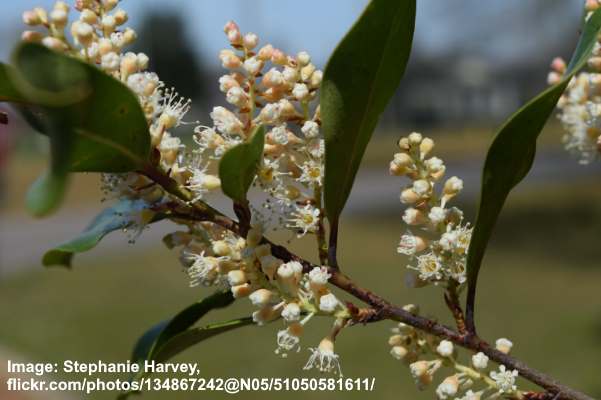
Carolina cherry laurel contains toxic substances and should not be ingested
Carolina cherry laurel contains toxic substances called cyanogenic glycosides that are poisonous to humans and animals. Therefore, you should also avoid eating the leaves or black berries of any varieties of cherry laurel plants, including Prunus caroliniana.
Other Varieties of Cherry Laurel
Suppose you have a compact garden or want to grow low-growing cherry laurel shrubs in your front or backyard. In that case, there are several hardy Prunus caroliniana cultivars to choose from.
Prunus caroliniana ‘Compacta’ — This dwarf cherry laurel cultivar grows 8 to 10 ft. (2.4 – 3 m) tall and tolerates heat, salty air, and drought. The compact shrub has closely spaced branches giving it an attractive appearance.
Prunus caroliniana ‘Cherry Ruffles’ — The highlight of ‘Cherry Ruffles’ is the wavy or ruffled leaves giving the plants a distinct appearance. New foliage emerges yellow or bronze and becomes glossy green.
Prunus caroliniana ‘Monus’ — Called ‘Bright N tight,’ this stunning evergreen cherry laurel cultivar grows 8 to 10 ft. (2.4 – 3 m) tall. It has silvery-green foliage and clusters of showy white flowers.
Related articles:
